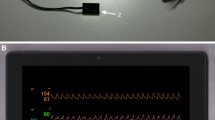Abstract
The pulse oximeter is commonly used in the operating room. We evaluated the use of a pulse oximeter to monitor systolic blood pressure in 20 healthy volunteers and 42 anesthetized patients. We compared the pulse oximeter method of measuring systolic blood pressure with the cuff methods using Korotkoff sounds and Doppler ultrasound as well as with direct pressure measurement through an intraarterial cannula. Systolic blood pressure values obtained by pulse oximeter correlated well with values obtained by other conventional methods. The best correlation was found with Doppler ultrasound (r = 0.996) and the worst with arterial cannulation (r = 0.880). We conclude that this method can be used intraoperatively to measure systolic blood pressure.
Similar content being viewed by others
References
Yoshiya I, Shimada Y, Tanaka K. Spectrophotometric monitoring of arterial oxygen saturation in the fingertip. Med Biol Eng Comput 1980;18:27–32
Yelderman M, New W Jr. Evaluation of pulse oximetry. Anesthesiology 1983;59:349–361
Kirkendall WM. Feinleib M, Freis ED, Mark AL. Recommendations for human blood pressure determination by sphygmomanometers. Dallas: American Heart Association, 1980:1146A-1155A (AHA Committee Report 70-019-B)
Lawson D, Norley I, Korbon G, et al. Blood flow limits and pulse oximeter signal detection. Anesthesiology 1987;67:599–603.
Gardner RM. Direct blood pressure measurement-dynamic response requirements. Anesthesiology 1981;54:227–236
Gravenstein JS, Paulus DA. Monitoring practice in clinical anesthesia. Philadelphia: Lippincott, 1982:37–88
Wallace C, Baker D, Alpert C, et al. Comparison of blood pressure measurement by Doppler and by pulse oximetry techniques. Anesth Analg 1987;66:1018–1019
Van Bergen FH, Weatherhead DS, Treloar AE, et al. Comparison of indirect and direct methods of measuring arterial blood pressure. Circulation 1954;10:481–490
Bruner JMR, Krenis LJ, Kunsman JM, Sherman AP. Comparison of direct and indirect methods of measuring arterial blood pressure. Med Instrum 1981;14:182–188
Hamilton WF, Dow P. An experimental study of the standing waves in the pulse propagated through the aorta. Am. J Physiol 1939;125:48–59
Author information
Authors and Affiliations
Rights and permissions
About this article
Cite this article
Talke, P., Nichols, R.J. & Traber, D.L. Does measurement of systolic blood pressure with a pulse oximeter correlate with conventional methods?. J Clin Monitor Comput 6, 5–9 (1990). https://doi.org/10.1007/BF02832176
Received:
Revised:
Accepted:
Issue Date:
DOI: https://doi.org/10.1007/BF02832176




